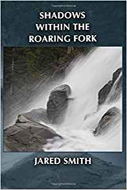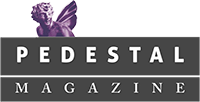 Jared Smith
Jared Smith
Shadows Within the Roaring Fork
Flowstone Press
Reviewer: Richard Allen Taylor
Early in his latest collection, Shadows Within the Roaring Fork, Jared Smith firmly establishes himself as a serious, truth-telling, common-sense kind of poet who would never fake his own death. So, it comes as a shock when he begins the poem, “Learning to Drive,”
Before I died I propped myself up and watched
the Leonid Meteor Shower over New York City…
Fact or fiction? The author appeared to be living when I heard him read last year. I had to ask, is “before I died” to be taken metaphorically or at face value? The poem continues:
. . .each molten stone etched across one vast glass,
for 20 minutes a torrent of heat and light across
horizons cutting through chimneys and furnaces.
You were scared and attentive and held my hand
but when they released me three weeks later you
said there were low clouds that night and no light
as far as you or others in the city could see.
Given that everything else in this collection seems “real,” I’m convinced the author actually had a death experience and was resuscitated by his doctors. The rest of the poem deals with Smith’s reaction to that experience. In the ultimate stanza he writes:
The radio in my car is often on but is turned off on
nights we are alone. The cell phone in my pocket
is muted and dead metal. The page thrown away.
We are learning to drive across the desert. The city
that we left behind us is nothing more than sand.
Whether this event was the sole catalyst or merely one of many factors influencing his abandonment of life in the big city, the poems in this collection often express a personal orientation that we used to call “back to nature.” Having lived in New York, Illinois, and Colorado, and after decades of writing, editing, and teaching, Smith has thirteen volumes of poetry to his credit. He divides his time between his home in Boulder and his “unimproved log cabin” in the Roosevelt National Forest. Judging from both his work in this collection, and from the persona he projects during his readings—even in his jacket photo, he sports a cowboy hat and silver mustache—he identifies more with the Rocky Mountain subculture that values nature and self-reliance than with the suit-and-tie urban capitalism he left behind. Yet he writes about both.
In “The Hudson Line,” for example, one of several poems about life in the city, Smith laments the sloppy condition of the commuter train he boards. “I track more snow / and foot crud from fellow passengers than God / into the aisles,” and later, “By the time the train has gotten me home, I have left / all the broken curses and shattered paychecks where they fell….”
In contrast, the title poem finds solace in the natural world, praising and describing a mountain river where
…this is the time of year when most
it changes and the insects hatched upon its surface
are swirled down and kegs of stone roll along
its bed and the minerals giving it its colors
seep into its passage, the fox that dipped its paws,
the bear way upstream that dragged across it
washing the heavy musk of winter in its spine…
Stylistically, Smith could never be accused of minimalism. The pentameter base of the above lines is short compared to many of his poems which employ much longer lines and accommodate expansive ideas, and lists—lots of lists—and sometimes, lists within lists. In “It Happens Right Here in Loveland, Colorado, at the G&W Sugar Beet Field Processing Center,” he writes in tribute to people engaged with the annual harvest:
we neighbors who oversee the farmland, and the migrants, and the scientists, too,
and the engineers who build furnaces and railroads and boxcars filled with night—
all looking for something sweet and meaningful at the center of our being.
…laborers, scientists, financial wizards who build steel and concrete monuments,
sweating together to find something clear and sweet within the darkest earth.
The long lines and democratically inclusive (we’re-all-in-this-together) sentiments invite comparisons to Whitman. From this poem, we learn not only who’s involved, but also what’s happening, as the author describes how the beets are harvested and processed, and where the final product, sugar, is shipped. The overarching theme here is that by working together, we can achieve something “sweet,” a word that can be taken literally or metaphorically.
In one of my favorite poems in this collection, “Invited to Make a Tourist Destination from an Abandoned Gold Mine, and Call It Art, in Hinsdale County, Colorado,” Smith offers several suggestions. Note the tongue in cheek.
I suggest that windows be placed on the slagheap,
lighting the stifling spaces where men worked collapsed
imprinting them into fossil images of humanists, and that
the music fed into your museum be of the wind barreling
through the twisted roots of stars across an open universe.
I suggest that you remove the stench of men’s sweat and
wash down the dried urine around each blind corner, clap
castanets on your fingers, bring in the cotton candy…
and put lots of bright-lit mirrors on the empty walls
and see if that won’t bring them in, keep them off the street.
Smith’s ironic, sarcastic advice hits the mark. How many historical treasures have been despoiled by turning them into tourist attractions? The voice in this poem reminds me of the Jeff Goldblum character in Jurassic Park.
In some ways, Jared Smith’s poems reflect the universe we live in—expanding in all directions, thanks to dark matter and dark energy, without losing density. There are passages in this collection that could have benefited from a comma or two, or trimming. There are some lists that could have been shortened. But these are minor issues compared to the overall excellence of the work. The author has a good ear, and these poems have a mesmerizing, rolling rhythm that demands to be heard. Read the poems aloud. Better yet, if you have an opportunity to attend one of Smith’s readings and listen to his bold, booming baritone, go.

